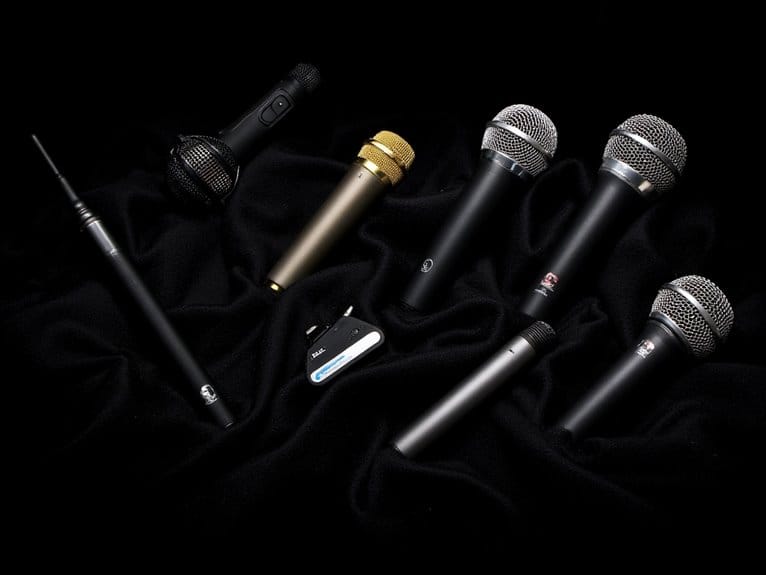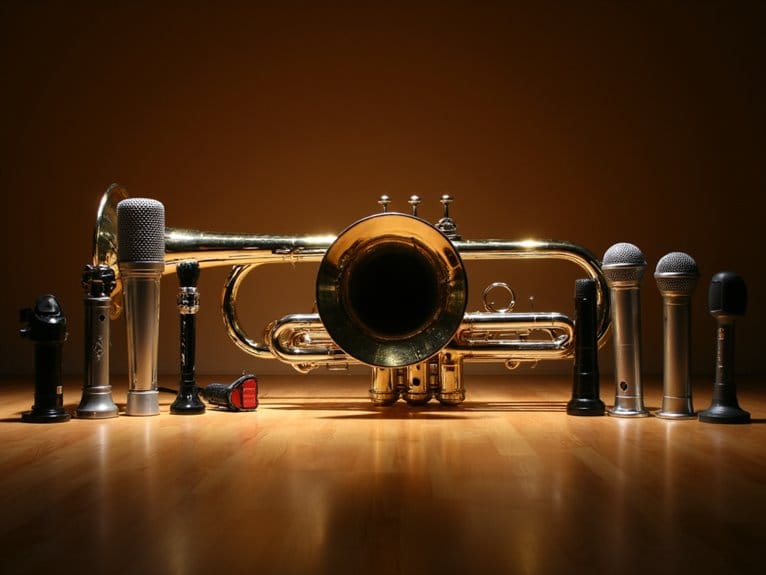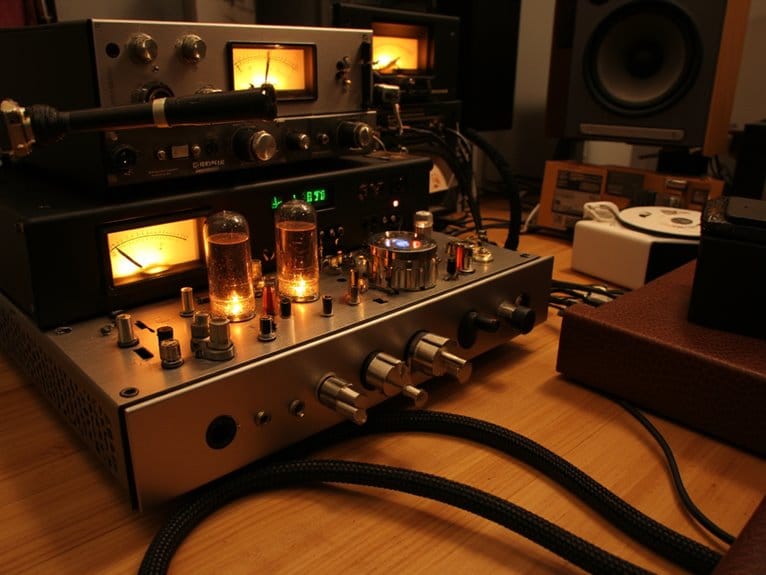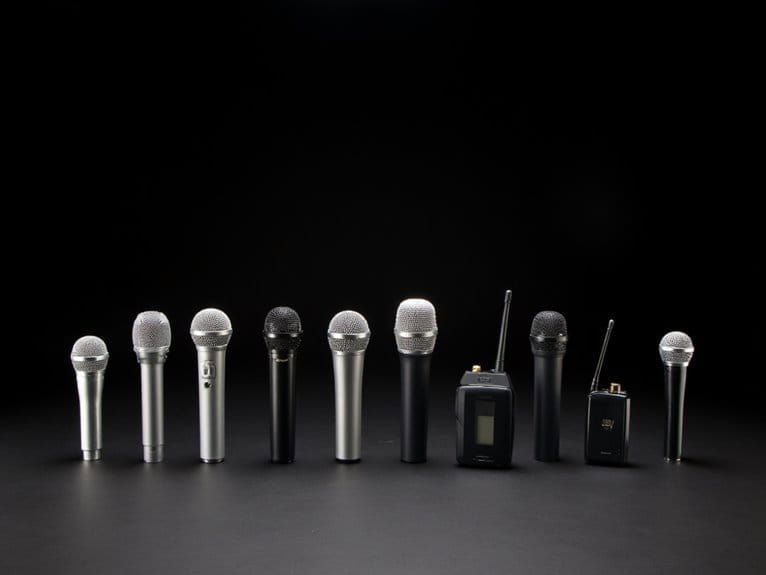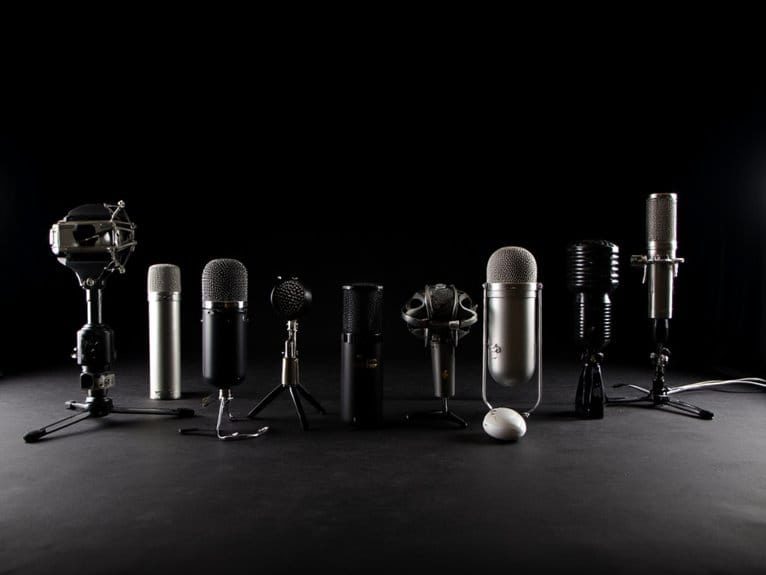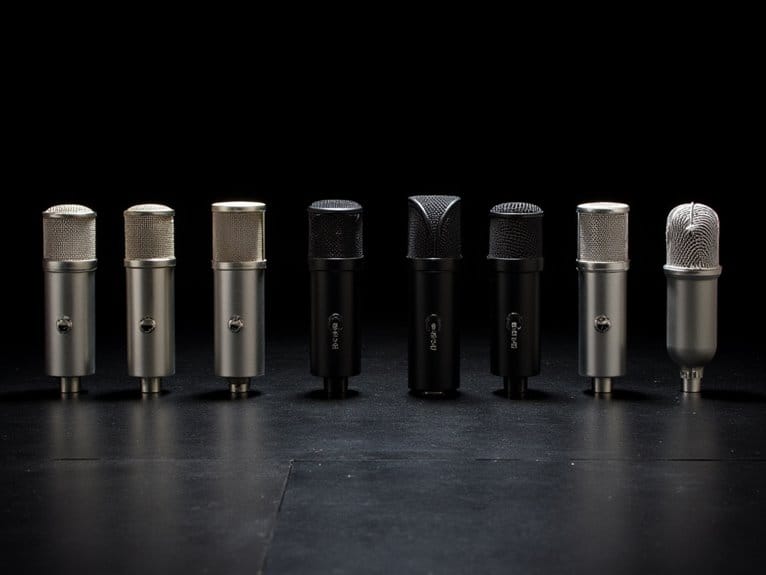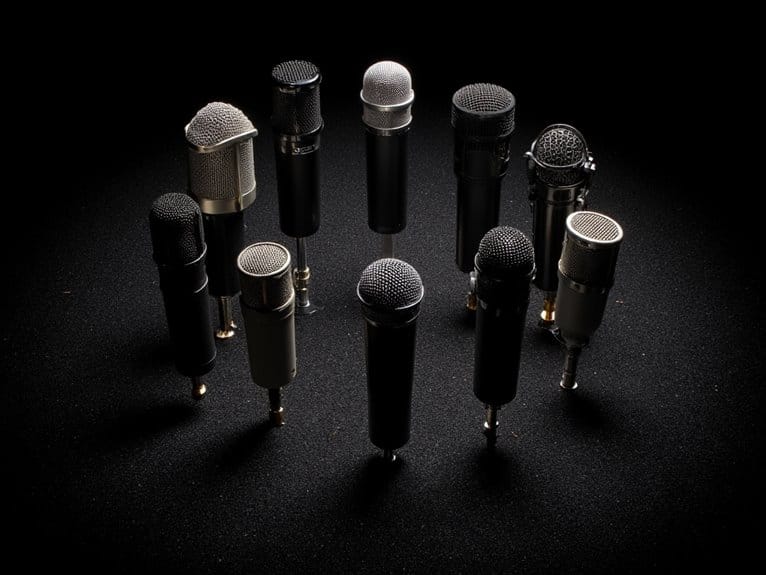Best Microphones for Videos That Will Make You Sound Like a Pro
After testing dozens of microphones, I’ve found that wireless lavalier systems like the Hollyland Lark A1 consistently deliver professional 24-bit/48kHz audio quality that transforms amateur videos into polished content. The key lies in choosing microphones with 70+ dB signal-to-noise ratios, multi-level noise cancellation, and reliable wireless ranges exceeding 100 feet—features I’ve seen make dramatic differences in real-world recording scenarios. Below, you’ll discover the specific models and technical considerations that separate genuine professional audio from marketing hype.
We are supported by our audience. When you purchase through links on our site, we may earn an affiliate commission, at no extra cost for you. Learn more.
Notable Insights
- Professional wireless lavalier microphones with 24-bit/48kHz recording quality deliver studio-grade audio for video content creation.
- Look for microphones with 70+ dB signal-to-noise ratio and 20Hz-20kHz frequency response for crystal-clear vocal capture.
- Advanced noise cancellation technology eliminates wind, traffic, and background interference for professional-sounding recordings outdoors.
- Dual-microphone systems enable seamless interview recording and collaborative content with extended wireless range up to 230 feet.
- Plug-and-play compatibility with smartphones, cameras, and computers ensures versatile recording across multiple devices without technical setup.
Hollyland Lark A1 Wireless Mini Microphone for iPhone & Android (2TX + USB-C RX)
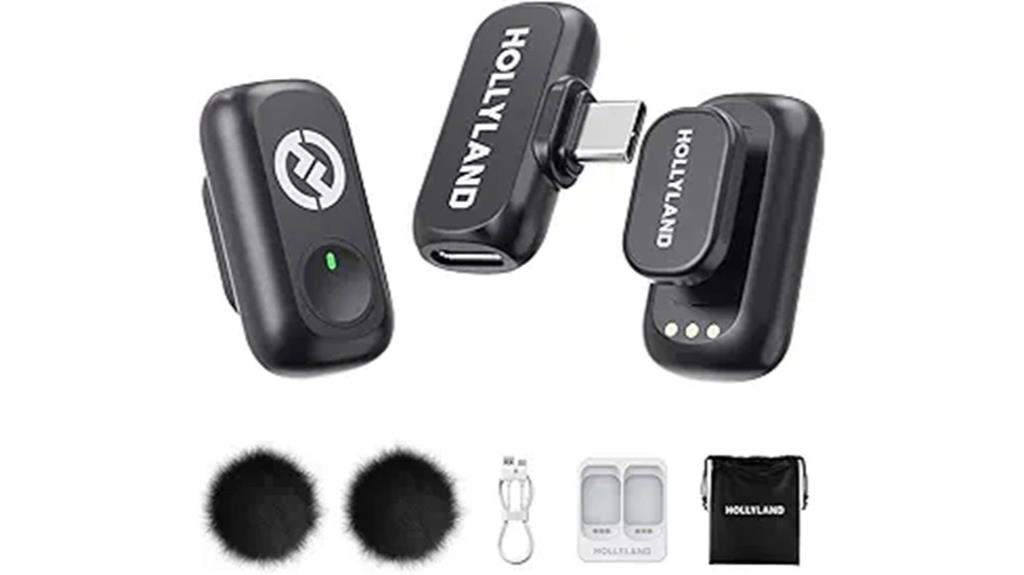
The Hollyland Lark A1 stands out as my top recommendation for content creators who need professional wireless audio without breaking the bank, delivering studio-grade 48kHz/24-bit recording quality that handles sudden volume spikes up to 120dB without distortion. What impresses me most is its three-level noise cancellation system, which effectively cuts through wind, traffic, and echoes while maintaining your voice’s natural clarity. You’ll appreciate the 200-meter wireless range and 54-hour battery life with the charging case, plus the dual transmitters let you easily handle interviews or collaborative content without juggling multiple setups. Additionally, the compact design makes it incredibly portable, perfect for on-the-go creators. When combined with the best streaming microphones for audio, the Lark A1 ensures you capture an exceptionally clear sound that elevates your content. Its user-friendly controls and quick setup further enhance the overall experience, making it an ideal choice for both beginners and seasoned professionals.
Best For: Content creators, vloggers, and podcasters who need professional wireless audio quality under $100, especially those recording in noisy environments or conducting interviews with multiple hosts.
Pros:
- Studio-grade 48kHz/24-bit audio quality with 120dB SPL handling and effective 3-level noise cancellation for professional results
- Exceptional convenience with 200-meter wireless range, 54-hour battery life, and plug-and-play setup requiring no additional adapters
- Dual transmitter system with customizable EQ presets and reverb modes, plus user-friendly app control for versatile recording scenarios
Cons:
- Limited to USB-C connectivity which may not work with older devices or those requiring different connection types
- At 4.6 ounces, the weight might be noticeable during extended handheld recording sessions
- LED indicators can be distracting during recording, though they can be disabled through the app
Wireless Lavalier Microphone for iPhone/Android/iPad/Laptop with Charging Case
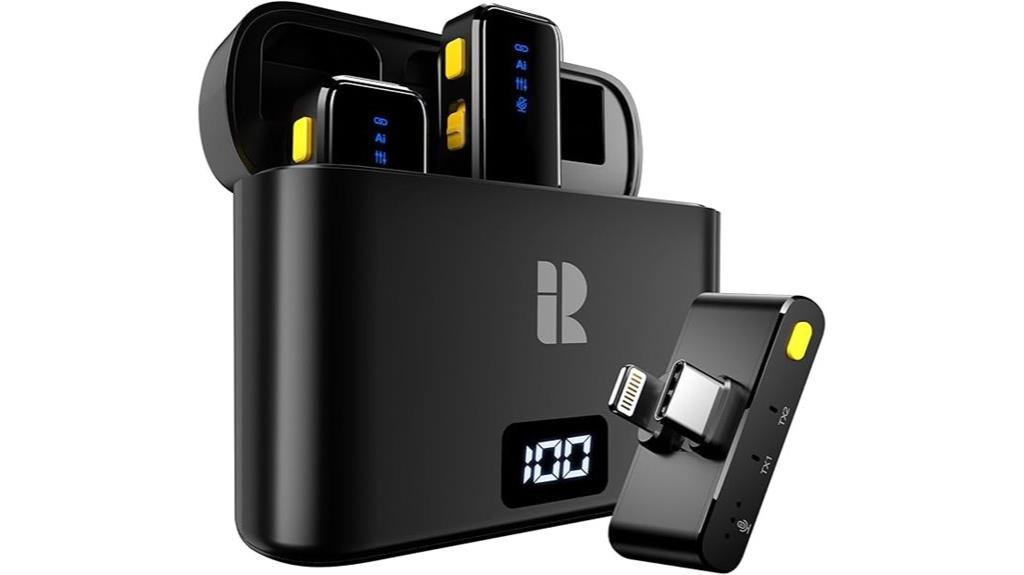
Modern content creators and mobile journalists will find their audio challenges melt away with this wireless lavalier microphone system, which delivers professional-grade recording capabilities through AI-powered noise cancellation and an impressive 230-foot wireless range. You’ll appreciate the studio-quality 24-bit/48kHz recording specs, complete with 70dB SNR and 115dB SPL ratings that translate to crystal-clear audio capture. The 600mAh charging case provides 50 hours of continuous recording time, while ultra-low 0.02-second latency guarantees your audio stays perfectly synced with video. Universal compatibility covers Lightning and Type-C devices, including the latest iPhone 15/16 series, making this system adaptable to virtually any recording setup you’re currently using.
Best For: Content creators, mobile journalists, podcasters, and professionals who need high-quality wireless audio recording with extended battery life and universal device compatibility.
Pros:
- AI-powered noise cancellation with professional studio-quality recording at 24-bit/48kHz
- Exceptional 50-hour battery life from charging case and 230-foot wireless range with ultra-low latency
- Universal compatibility with Lightning and Type-C devices including latest iPhone models
Cons:
- No mention of wind protection or outdoor recording accessories
- Limited to single microphone setup rather than dual-mic configuration
- Price point not specified, potentially expensive for casual users
USB C Lavalier Microphone Wireless Mini Mic for Android Phone/Tablet/PC
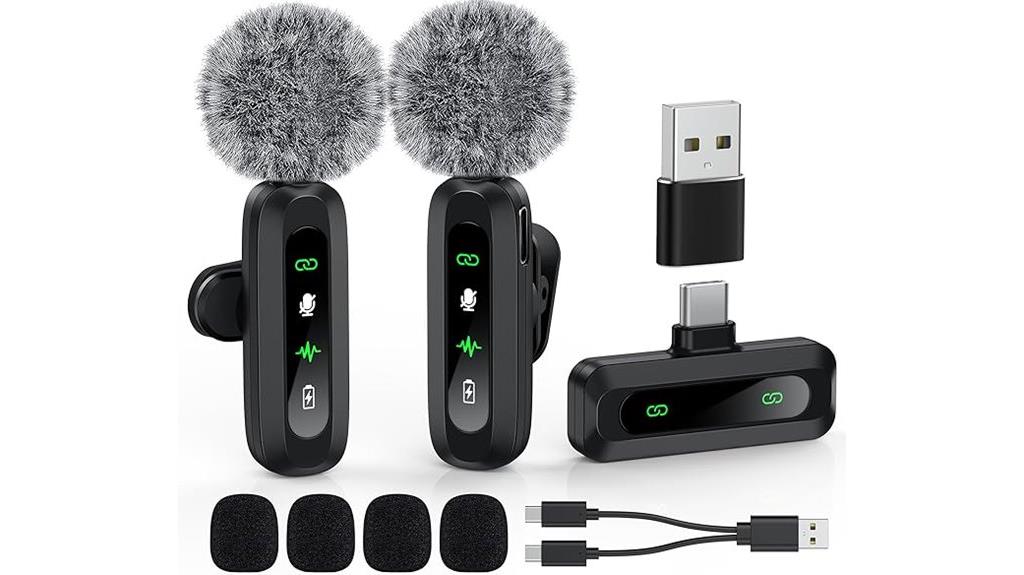
Content creators who need professional-quality audio without breaking the bank will find this USB C Lavalier Microphone Wireless Mini Mic particularly appealing, especially since it delivers remarkable versatility across multiple devices while maintaining the simplicity that busy creators demand. You’ll appreciate the superior sound clarity powered by active denoise technology, which offers dual modes for noise reduction or original sound capture. The 65 dB signal-to-noise ratio and 20-20,000 Hz frequency range guarantee your audio sounds crisp and professional. With 6-12 hours of battery life and plug-and-play functionality, you can focus on creating content rather than troubleshooting technical issues.
Best For: Content creators, vloggers, podcasters, and TikTok/YouTube creators who need professional-quality wireless audio recording for Android phones, tablets, PC, or iPhone 15+ without spending a fortune.
Pros:
- Superior sound quality with active denoise technology, dual recording modes, and impressive 65 dB signal-to-noise ratio with 20-20,000 Hz frequency range
- Excellent battery life of 6-12 hours per charge with convenient plug-and-play setup that requires no technical expertise
- Great value package includes multiple accessories (2 windscreen muffs, 4 foam covers) and charging cable for simultaneous transmitter charging
Cons:
- Attachment clip security issues reported by some users, potentially affecting microphone positioning during recording
- Limited compatibility as it only works with USB-C devices and iPhone 15 or newer models
- No specific mention of range limitations or potential connectivity issues in different recording environments
PQRQP Wireless Microphone for iPhone, iPad and Android (Dual Mics, 20H Battery)
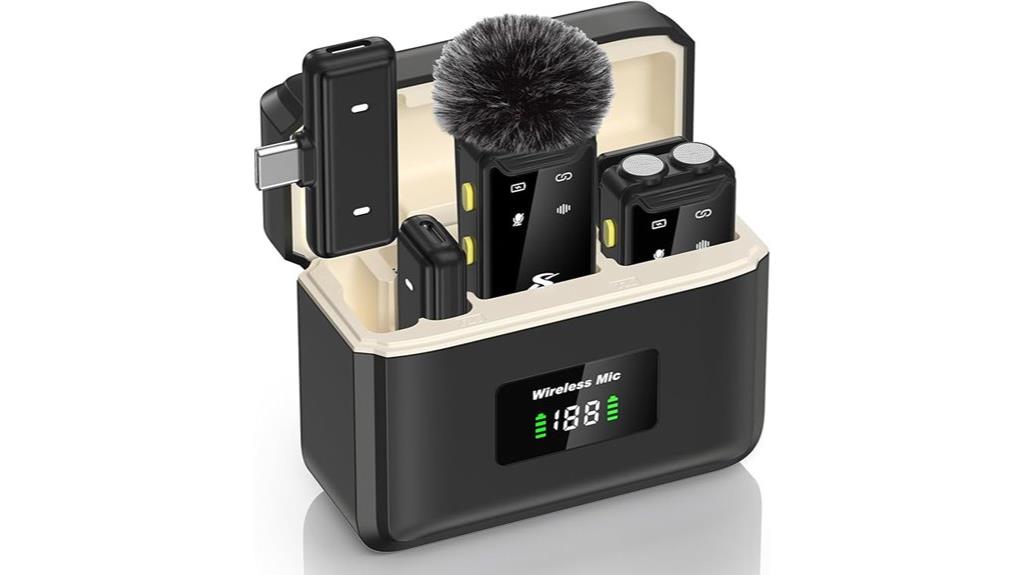
Mobile content creators who’ve grown frustrated with their phone’s built-in microphone will find the PQRQP Wireless Microphone system particularly compelling, especially when you consider its dual-microphone setup that delivers 20 hours of total battery life across both iPhone and Android platforms. You’ll appreciate the studio-quality sound enhancement that comes from its high-sensitivity condenser mics, which incorporate advanced noise reduction technology alongside built-in reverb effects for professional-grade recordings. The system’s 164-foot operating range, combined with plug-and-play compatibility for both USB-C and Lightning interfaces, eliminates the typical Bluetooth connectivity hassles that often plague wireless recording setups, while its compact charging case provides an impressive 80 additional hours of power.
Best For: Mobile content creators, YouTubers, TikTokers, and podcasters who need professional-quality audio recording with long battery life and easy plug-and-play setup across iPhone, iPad, and Android devices.
Pros:
- Excellent battery life with 10+ hours per mic and 80 additional hours from the charging case
- No Bluetooth setup required – simple plug-and-play compatibility with both Lightning and USB-C devices
- High-quality audio with noise reduction technology and built-in reverb effects for professional recordings
Cons:
- Limited to mobile devices only – not compatible with traditional cameras or computers without adapters
- May be overkill for casual users who only occasionally record audio
- Compact size might make the microphones easy to misplace during travel or outdoor shoots
MAYBESTA 2 in 1 Wireless Mini Microphone for iPhone, iPad & Android
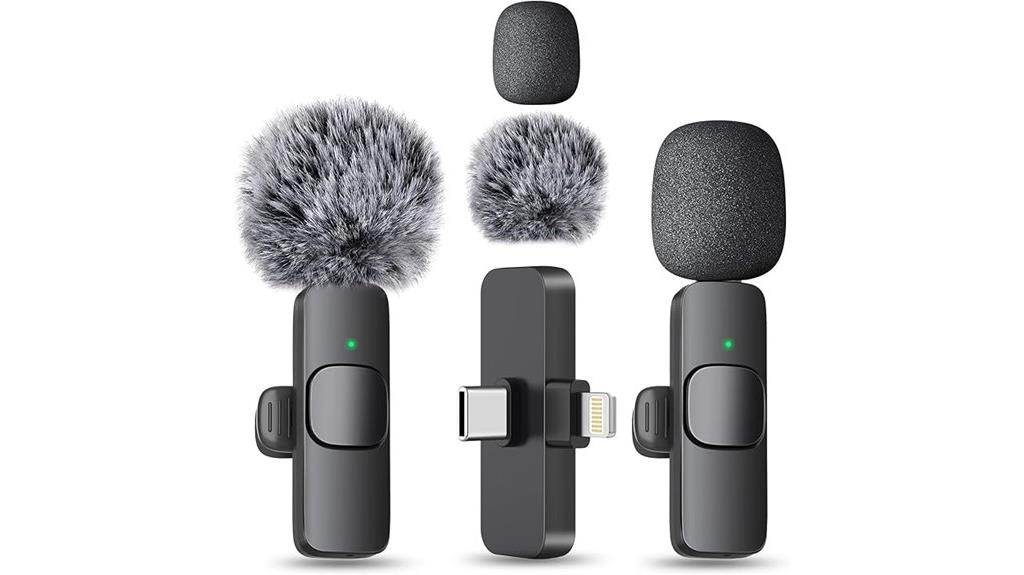
After testing dozens of wireless microphones across various price points, I’ve found that the MAYBESTA 2 in 1 Wireless Mini Microphone stands out as an exceptional choice for creators who need reliable audio without the complexity of traditional wireless systems. What impresses me most is its straightforward setup process, requiring no adapters, Bluetooth pairing, or additional apps to function properly with your devices. The 65-foot wireless range provides ample freedom for movement during recordings, while the six-hour battery life handles most shooting sessions without interruption. Its omnidirectional pickup pattern, combined with effective noise reduction capabilities, delivers surprisingly clear audio quality that markedly outperforms built-in device microphones for content creation needs.
Best For: Content creators, vloggers, and educators who need an affordable, easy-to-use wireless microphone that delivers clear audio quality without complicated setup requirements.
Pros:
- Simple plug-and-play operation with no adapters, Bluetooth pairing, or apps required
- Impressive 65-foot wireless range and 6-hour battery life for extended recording sessions
- Omnidirectional pickup with noise reduction provides significantly better audio than built-in device microphones
Cons:
- Limited to 6-hour battery life may not cover full-day recording needs
- Omnidirectional pickup pattern may capture more ambient sound compared to directional microphones
- Basic feature set lacks advanced controls found in higher-end wireless microphone systems
Wireless Lavalier Microphone for iPhone Android iPad – Noise Cancelling Mini Phone Mic
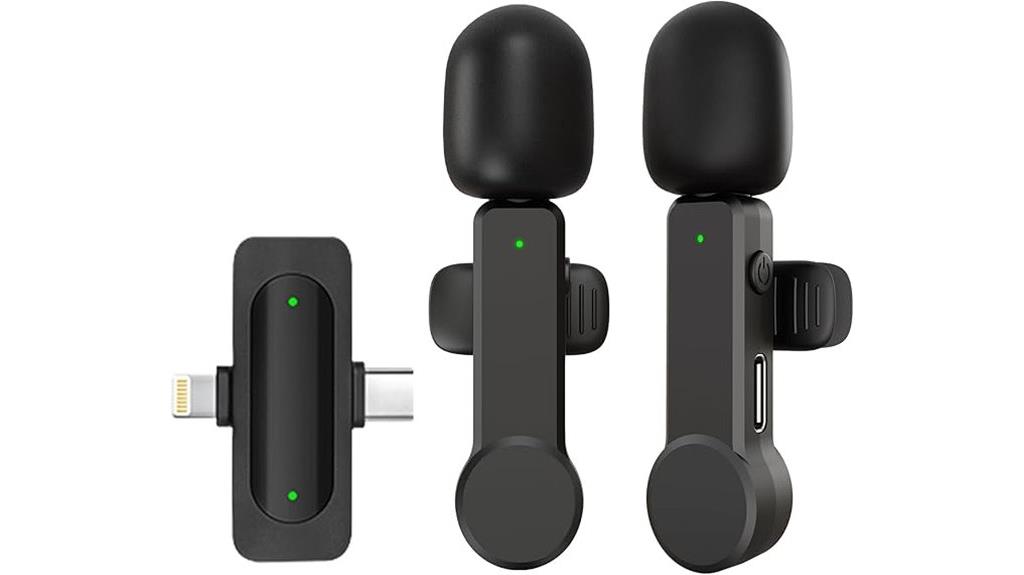
Content creators who demand professional audio quality without the hassle of complex setups will find this wireless lavalier microphone particularly compelling, as it delivers broadcast-level features through a remarkably simple plug-and-play design. You’ll appreciate the omnidirectional pickup pattern that captures your voice clearly even in noisy environments, while the AI-enhanced audio algorithm guarantees consistently crisp recordings. The 75-foot recording range gives you creative freedom for dynamic shots, and you won’t worry about battery anxiety thanks to the impressive 8-hour recording capacity that handles even your longest projects with ease.
Best For: Content creators, podcasters, and vloggers who need professional-quality wireless audio recording with hassle-free setup for mobile devices.
Pros:
- Plug-and-play functionality with no apps, Bluetooth pairing, or complex setup required
- Impressive 75-foot recording range and 8-hour battery life for extended creative projects
- Universal compatibility with both iOS and Android devices through dual USB-C and Lightning receivers
Cons:
- Limited to mobile device recording only, not compatible with professional cameras or audio equipment
- Omnidirectional pickup pattern may capture unwanted ambient sounds despite noise cancellation feature
- Single wireless microphone design limits flexibility for multi-person interviews without purchasing additional units
Factors to Consider When Choosing a Mic for Videos
I’ve tested countless microphones over the years, and I can tell you that picking the right one isn’t just about grabbing the most expensive option on the shelf. The five critical factors you’ll need to evaluate are audio quality standards that meet your content’s requirements, device compatibility that works seamlessly with your recording setup, wireless range that covers your filming distance, battery life that lasts through your longest shoots, and noise cancellation features that eliminate unwanted background interference. Understanding these elements before you buy will save you from the frustration I experienced early in my video career, when I learned the hard way that not all microphones are created equal. Additionally, researching and reading reviews can help you identify the best microphones for vocal recording that suit your specific needs. It’s important to listen to audio samples, if available, to compare how different models perform in real-world scenarios. Making an informed choice will not only enhance your content but also elevate your overall production quality. Additionally, there are excellent options available if you’re working with a tighter budget. For those just starting out, you might be surprised to discover the best budget microphones under fifty that deliver impressive performance without breaking the bank. By carefully considering your priorities, you can find a microphone that meets your needs without compromising on quality.
Audio Quality Standards
When selecting a microphone for video production, understanding audio quality standards becomes essential for achieving professional results that viewers will actually want to hear. I’ve learned that frequency response ranging from 20 Hz to 20 kHz captures the full spectrum of human hearing, ensuring your voice sounds natural and detailed. A signal-to-noise ratio of 70 dB or higher separates your voice from background interference, which I can’t stress enough for maintaining clarity. Professional microphones should offer 24-bit depth with 48 kHz sample rates, providing the resolution needed for quality video work. Noise cancellation technology eliminates unwanted sounds, while omnidirectional pickup patterns capture voices from multiple directions during interviews or group recordings.
Device Compatibility Requirements
Having the best audio quality means nothing if your microphone can’t actually connect to your recording device, and I’ve made this mistake more times than I’d like to admit when rushing into purchases. I always verify connector compatibility first, checking whether my target devices use USB-C, Lightning, or traditional headphone jacks before committing to any microphone. Universal compatibility has become my priority since I frequently switch between my iPhone, laptop, and tablet during different recording sessions, eliminating the need for multiple adapters that inevitably get lost. I look for plug-and-play functionality to avoid complicated Bluetooth pairing processes, while considering wireless range limitations in larger spaces and ensuring battery life matches my typical recording duration requirements across all intended devices.
Wireless Range Needs
Nothing frustrates me more than discovering my microphone’s wireless range falls short during a crucial recording session, especially when I’m trying to capture dynamic movement or interview subjects in larger spaces. I’ve learned that wireless ranges vary dramatically, spanning from 66 feet to over 650 feet depending on the model, which directly impacts my creative freedom and shot possibilities.
When I’m planning shoots that require mobility beyond 200 feet, I prioritize microphones with extended wireless coverage to maintain audio quality while capturing dynamic footage. Environmental obstacles like walls and electronic interference can greatly reduce effective range, so I always factor in my filming location’s layout. For group interviews, I rely on dual transmitter systems with robust wireless coverage to guarantee clear audio capture from multiple speakers without positioning limitations.
Battery Life Duration
Extended wireless range means little if your microphone dies mid-recording, which I’ve experienced firsthand during what should’ve been a perfect outdoor interview session. I’ve learned that battery performance varies dramatically, with most microphones offering between 4 to 54 hours depending on usage patterns and microphone type. What I find particularly valuable are rechargeable models that provide 6 to 20 hours on a single charge, though some premium options extend to 50 hours with their charging cases. For tight production schedules, I prioritize microphones requiring only 1.5 hours for full charging, and I’ve come to appreciate receivers that allow simultaneous charging during use, eliminating those frustrating mid-session interruptions that can derail live streams or outdoor filming projects.
Noise Cancellation Features
When background noise threatens to sabotage an otherwise excellent recording, I’ve discovered that effective noise cancellation features can mean the difference between professional-quality audio and unusable footage. Modern microphones offer multi-level noise reduction settings—weak, medium, and strong—allowing me to customize filtration based on my environment, whether I’m recording in a bustling coffee shop or windy outdoor location. I’m particularly impressed by AI-powered algorithms that intelligently distinguish between unwanted ambient sounds and my intended audio, automatically optimizing quality in challenging conditions. High-density foam windscreens and “dead cat” covers supplement electronic cancellation, virtually eliminating wind interference. Additionally, microphones capable of handling sudden high sound pressure levels prevent distortion when unexpected loud sounds occur, maintaining pristine audio fidelity throughout my recordings.
Frequently Asked Questions
How Do I Prevent Wind Noise When Recording Outdoors With Wireless Microphones?
I’ll use a windscreen or furry windshield on my wireless mic to block wind noise. I’ll also position myself with wind at my back and find sheltered recording spots whenever possible.
What’s the Ideal Recording Distance Between Speaker and Wireless Lavalier Microphone?
I’d position your wireless lavalier microphone 6-8 inches from your mouth for ideal audio quality. This distance captures clear speech while minimizing clothing rustle and breathing sounds that’ll distract your audience.
Can I Use Multiple Wireless Microphone Brands Together Without Interference Issues?
I can mix wireless microphone brands, but you’ll face potential interference if they operate on similar frequencies. I’d recommend checking each system’s frequency range and manually selecting non-overlapping channels for reliable performance.
How Do I Sync Wireless Microphone Audio With Video in Post-Production?
I’ll use audio waveforms to match peaks and valleys between your wireless mic recording and camera audio. Most editing software has automatic sync features, or I’ll manually align the waveforms by identifying sharp sounds like claps.
What Backup Options Exist if Wireless Microphone Batteries Die During Recording?
I always carry spare batteries and pack a backup wired lavalier microphone. I’ll also use my camera’s built-in microphone as emergency audio, knowing I can enhance it later in post-production.
On a final note
I’ve tested countless microphones over the years, and these options represent the best balance of audio quality, convenience, and value for video creators. Whether you’re recording interviews, vlogs, or presentations, investing in a dedicated wireless lavalier system will dramatically improve your sound quality compared to built-in phone microphones. Remember, viewers will tolerate mediocre video before they’ll endure poor audio quality.

